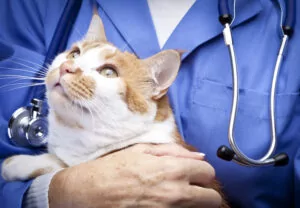Jaw Bone Cancer in Cats
Osteosarcoma is a bone cancer that can occur in the jaw. It is one of the more common forms of bone cancer in felines; however, it is also very rare.
Jaw bone cancer in cats occurs when the cat is suffering from osteosarcoma. Some symptoms include difficulty eating, problems opening the mouth, loss of appetite, and pain in the jaw. Treatment may require pain medication and radiation to inhibit the progression of the tumor.
Osteosarcoma is very aggressive, and early treatment and detection are vital for a favorable prognosis. If you want to understand jaw bone cancer in felines, read this article.

What Is Osteosarcoma?
Osteosarcoma is a cancer of the bone, which is widespread in felines. It is highly aggressive and often spreads to other areas of the body quickly, so early detection and treatment are crucial. Osteosarcoma can appear in the upper or lower part of the cat’s jawbone. The good news is that osteosarcoma in cats is rare.
Osteosarcoma forms in the bone, and it arises from an abnormal production of cells as cancer starts to destroy the bone, which causes pain and inflammation. Osteosarcoma can commonly occur in the long bones of the legs, limbs, pelvis, and paws.
What Are The Warning Signs of Osteosarcoma in Cats?
A major sign of osteosarcoma in cats is a difference in their behavior. You should always observe your cat to see if their mood has changed or if they are not acting like themselves. Some of the warning signs of osteosarcoma in cats include:
- Difficulty eating
- Swelling or a mass
- Loss of appetite
- Lack of energy
- General weakness
- Progressively worsening pain
Cats with jaw tumors may have difficulty opening their mouth. The cat may also lose weight because they do not want to eat. As cancer progresses, there may be fractures and jaw misalignment can occur.
What Are The Various Kinds of Bone Cancers?
Primary bone cancer refers to a disease that begins in the bone. It can grow on the exterior of the bone, on the outer layer, or the center of the bone. There are distinct types of bone tumors:
- Chondrosarcoma is a rare cancer that starts in the bones but sometimes occurs in the soft tissue close to the bones. It mainly occurs in the pelvis, hips, and or shoulder.
- Fibrosarcoma is a cancerous growth that begins in the connective tissues at the ends of bones in the arms or legs and then disperses throughout the body.
- Hemangiosarcoma is often difficult to distinguish from osteosarcoma when it occurs in the bone. It is an aggressive tumor.
- Synovial Cell Carcinoma is cancer from different soft tissue types and is frequently situated in the elbow, knee, and shoulder blades. It often metastasizes into the lung.
- Osteosarcoma is the most aggressive and common tumor found in cats. It starts in the cells that develop bones.
Chondrosarcoma grows from the cartilage. Fibrosarcoma typically refers to a locally aggressive form of cancer. Synovial cell carcinoma is the most common primary joint tumor. Dogs are more likely to have primary bone cancer than cats.
How Do Veterinarians Diagnose Osteosarcoma?
Veterinarians diagnose osteosarcoma by conducting a physical exam first. They take radiographs of the affected area and x-rays of the pelvis and chest to see if cancer has spread. The vet will also look for tissue changes and perform a chest CT scan and abdominal ultrasound for evidence of metastasis.
Organ function will be observed through a chemistry profile and testing for a complete blood count. Elevations of specific cells may indicate cancer. There will also be a fine needle aspiration and biopsy in which a needle is inserted into the tumor. A whole-body scan may be performed to detect the spread of cancer.
A heart ultrasound will be performed, and a urinalysis will be done to determine kidney health. Images and tests will help the vet see how advanced the cancer has become. Once there is an identification, your vet can tell how far the cancer has spread. Most osteosarcoma cancers will travel to the lungs.
Treatment of Osteosarcoma
Pet parents have options to help improve their cat’s quality of life. The objective is to keep the feline as comfortable as feasible. Pain control methods will be applied to help the affected cat. Some examples of pain management options include:
- Pain medication
- Radiation therapy
- Surgery to remove the tumor
- Amputation (depending on the location)
Some vets will prescribe gabapentin or NSAIDs, such as Robenacoxib, to help control the cat’s pain. Radiation therapy facilitates putting a stop to the progress of cancer cells and shrinking tumors. It does this by injuring the DNA in cancer cells. It can offer local control of sarcomas.
The radiation is delivered through beams or radioactive pellets while the cat is under anesthesia. Radiation therapy has been shown to improve pain in cats with osteosarcoma and is generally the most common treatment administered, as it can prevent cancer progression.
Removing part of the jaw may be required in cats with osteosarcoma of the jaw. The average survival rate for cats with osteosarcoma who receive treatment is about two to three years. The location of the tumor is crucial to figure out the prognosis.
How to Make Your Cat with Cancer More Comfortable
If you have a cat diagnosed with a terminal illness, knowing the best way to care for them is the hardest part.
Even though it is likely that they have lost their appetite, you should give them enough water to keep them hydrated. Additionally, give them their pain medicine when they need it.
Find out which medicines you can give at home and which must be administered by your vet. You can give your cat a heated bed to keep them warm since cats with cancer tend to have difficulty with thermoregulation. Find special treats that were designed for sensitive stomachs for easy digestion. This is especially important if they are struggling with digestion or nausea.
Playing with your cat during this time will encourage bonding, and it helps them mentally and physically. Play with your cat for a short time, taking care not to wear them down. Let your cat get plenty of rest. You could also give them a massage and soothe them. Use simple stroking and gently run your hands from the base of their tail to their head with light to medium pressure.
Physical contact is essential for your cat to know you will be there for them and reassure them. Keep them company and cuddle with them. Let them snooze in your bed with you at night to make them feel secure. Most importantly, let them realize how much you love them and have treasured the time you spent with them.
Conclusion
Osteosarcoma is a cancer of the bone and can occur in cats in the jaw. For cats with osteosarcoma, removal of a portion of the jaw may be required for treatment. If you notice any symptoms of osteosarcoma in your cat, schedule a visit with your veterinarian as soon as possible. Early discovery and therapy are critical for them to have the best prognosis.
If your pet is battling cancer, Pawsitive Integrative Veterinary Care is here to help. Located in Mishawaka, Indiana, we give specialty veterinary care to pets all over the country. Give us a call at (574) 256-1871 or visit us online today.

